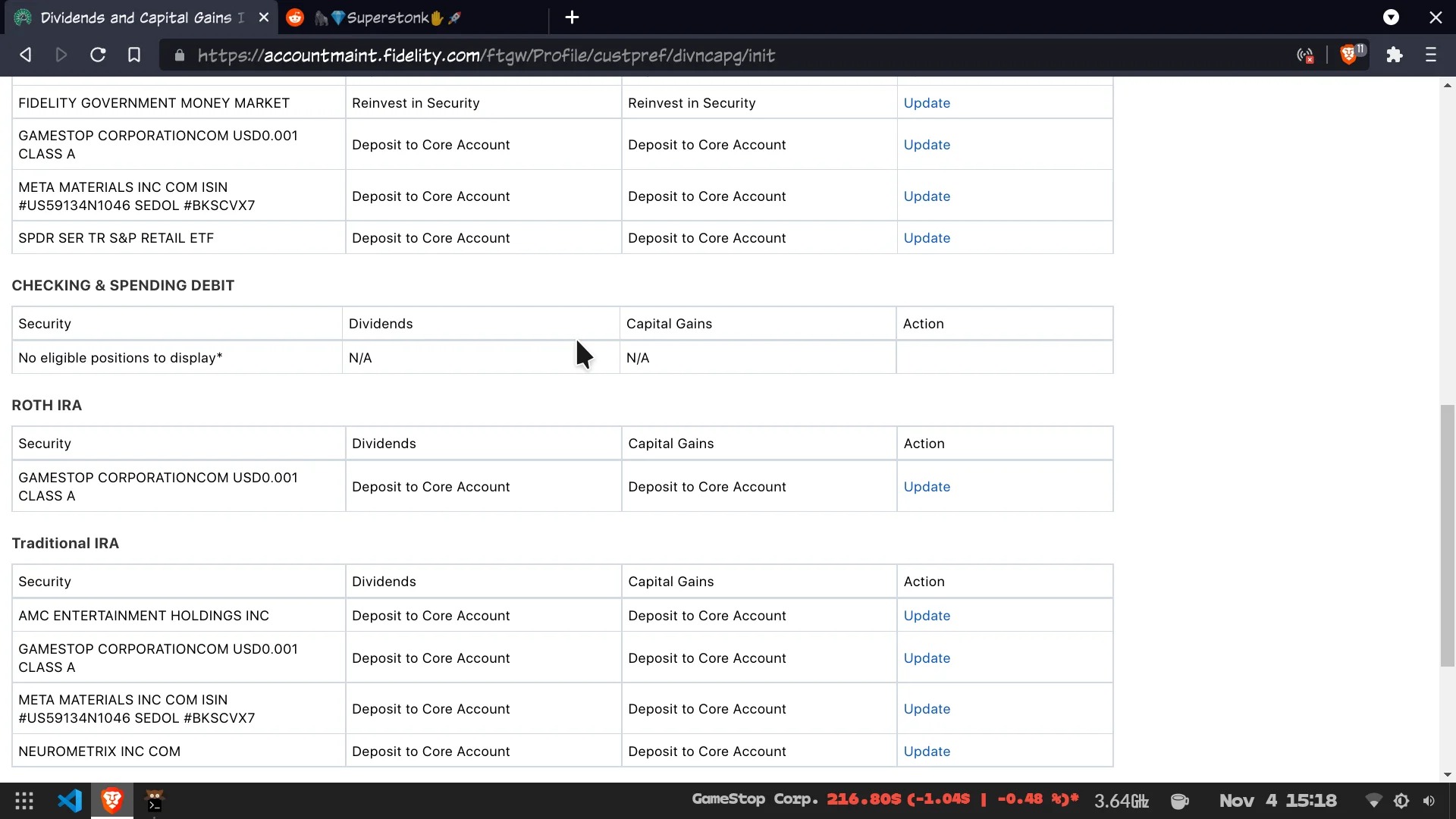Home>Finance>Where Are Unrealized Gains And Losses From Investment Securities Displayed?


Finance
Where Are Unrealized Gains And Losses From Investment Securities Displayed?
Published: November 26, 2023
Learn where unrealized gains and losses from investment securities are displayed in finance. Find out how to track and manage your investments effectively.
(Many of the links in this article redirect to a specific reviewed product. Your purchase of these products through affiliate links helps to generate commission for LiveWell, at no extra cost. Learn more)
Table of Contents
Introduction
Investment securities play a crucial role in the financial activities of individuals, businesses, and institutions. They can include stocks, bonds, mutual funds, and other financial instruments that are purchased with the intention of generating a return on investment. One important aspect of investment securities is the concept of unrealized gains and losses. These gains and losses arise when the value of an investment fluctuates but has not yet been realized through a sale or disposal of the security.
Understanding where unrealized gains and losses from investment securities are displayed is essential for accurate financial reporting and analysis. This information allows businesses and investors to assess the financial health and performance of their investment portfolios. In this article, we will explore where unrealized gains and losses from investment securities are typically displayed in financial statements.
To provide a comprehensive understanding, we will discuss the statement of financial position (balance sheet) and the statement of comprehensive income (income statement). Additionally, we will delve into the disclosure notes that provide further details on the investment securities and their impact on financial statements. Lastly, we will explore the importance of financial analysis and interpretation to gain insights into the significance of unrealized gains and losses.
By the end of this article, you will have a clear understanding of how unrealized gains and losses from investment securities are presented in financial statements and their relevance in assessing overall financial performance.
Overview of Investment Securities
Investment securities refer to financial assets that are acquired with the primary purpose of earning a return on investment. These securities can take various forms, including stocks, bonds, mutual funds, options, derivatives, and exchange-traded funds (ETFs). They provide investors with the opportunity to grow their wealth and generate income.
Stocks, also known as equities, represent ownership shares in a company. When investors buy stocks, they become partial owners and have the potential to benefit from the company’s growth and profitability. Bonds, on the other hand, represent debt instruments issued by governments, corporations, or municipalities to raise capital. Bondholders receive periodic interest payments and the return of the principal amount at maturity.
Mutual funds are investment vehicles that pool money from multiple investors to invest in a diversified portfolio of securities. This provides investors with the benefit of professional management and broad market exposure. Options are financial derivatives that give investors the right, but not the obligation, to buy or sell an underlying asset at a predetermined price within a specified period of time.
Exchange-traded funds (ETFs) are similar to mutual funds but trade on stock exchanges like individual stocks. They offer investors a way to gain exposure to a specific market index or sector while enjoying the liquidity and flexibility of trading on an exchange.
Investment securities provide various benefits to investors, such as potential capital appreciation, dividend income, interest payments, and portfolio diversification. However, they come with their share of risks, including market volatility, issuer default, interest rate fluctuations, and geopolitical factors.
Overall, investment securities offer investors the opportunity to achieve their financial goals by participating in the growth and performance of various asset classes. Understanding the different types of investment securities and their characteristics is crucial for making informed investment decisions.
Unrealized Gains and Losses Explained
Unrealized gains and losses occur when the value of an investment security changes but has not yet been realized through a sale or disposal. These gains and losses are called “unrealized” because they represent potential profits or losses that have not been converted into actual cash flow.
Investment securities are marked to market, meaning their value is reevaluated periodically based on their current market price. As a result, the value of these securities can fluctuate, leading to unrealized gains or losses. For example, if the market value of a stock held in an investment portfolio increases, the investor experiences an unrealized gain. Conversely, if the market value of a security decreases, the investor faces an unrealized loss.
It is important to note that unrealized gains and losses have no impact on an entity’s cash flow until the investment securities are sold. They only affect the reported value of the investment securities on the financial statements. It is the sale of these securities that converts unrealized gains and losses into realized gains and losses, which then impact the entity’s cash flow.
Unrealized gains and losses play a significant role in assessing the performance of investment portfolios. They reflect the fluctuations in market values and provide insights into the potential future performance of the investments. However, it’s essential to exercise caution when interpreting unrealized gains and losses as they are subject to market volatility and may not accurately represent the long-term value of the investment.
Moreover, the accounting treatment of unrealized gains and losses depends on the accounting framework followed. Under generally accepted accounting principles (GAAP), investment securities are classified as either trading securities, available-for-sale securities, or held-to-maturity securities. The classification determines how unrealized gains and losses are reported and disclosed in the financial statements.
Understanding the concept of unrealized gains and losses is essential for investors, financial analysts, and other stakeholders in evaluating the performance and potential risks associated with investment securities. It provides valuable insights into the volatility and growth potential of investments, helping in making informed decisions about managing and optimizing investment portfolios.
Statement of Financial Position (Balance Sheet)
The statement of financial position, also known as the balance sheet, is a financial statement that provides a snapshot of a company’s financial position at a specific point in time. It presents the assets, liabilities, and shareholders’ equity of an entity.
When it comes to investment securities, unrealized gains and losses from these securities are typically displayed in the balance sheet. The classification of investment securities on the balance sheet depends on their intended holding period.
- Trading Securities: These are investment securities that are actively traded and intended for short-term profit. Unrealized gains and losses from trading securities are reported in the income statement as part of the net income. The carrying value of trading securities is adjusted to reflect these unrealized gains or losses.
- Available-for-Sale Securities: These are investment securities that are not classified as trading securities or held-to-maturity securities. Unrealized gains and losses from available-for-sale securities are reported as a separate component of shareholders’ equity in the balance sheet. They are included in a line item called “Unrealized Gain/Loss on Investment Securities” or a similar name.
- Held-to-Maturity Securities: These are investment securities that the entity intends to hold until their maturity date. The intent to hold them until maturity distinguishes them from trading and available-for-sale securities. Unrealized gains and losses from held-to-maturity securities are not typically recognized or disclosed in the balance sheet.
The reporting of unrealized gains and losses on investment securities in the balance sheet provides transparency on the company’s exposure to market fluctuations and the potential risk associated with these investments. It presents a complete picture of the financial position, including the value of the investment portfolio and its impact on shareholders’ equity.
It is important to note that the presentation and disclosure requirements for investment securities can vary depending on the accounting standards followed in a particular jurisdiction. Companies must adhere to these guidelines to provide accurate and transparent financial information to stakeholders.
The balance sheet not only reflects the current value of investment securities but also presents other crucial financial information such as current assets, non-current assets, current liabilities, non-current liabilities, and shareholders’ equity. This comprehensive view allows stakeholders to understand the financial health of the company and its ability to meet its obligations.
Overall, the balance sheet provides a clear and concise overview of the company’s investments, including the unrealized gains and losses from these securities. It serves as a valuable tool for evaluating the financial position, liquidity, and solvency of an entity.
Statement of Comprehensive Income (Income Statement)
The statement of comprehensive income, also known as the income statement, is a financial statement that summarizes the revenues, expenses, gains, and losses of an entity over a specific period of time. It provides insights into the profitability and financial performance of a company.
When it comes to investment securities, unrealized gains and losses are not typically recognized in the income statement. Instead, only realized gains and losses are included as part of the net income. Unrealized gains and losses, also known as holding gains and losses, are not considered as revenue or expenses since they have not been realized through a sale or disposal of the investment securities.
The income statement includes various line items such as revenues from sales, interest income, dividend income, cost of goods sold, operating expenses, and taxes. It calculates the net income by subtracting the total expenses from the total revenues. The net income represents the company’s profit or loss for the given period.
However, it is important to note that the income statement may include other line items related to investment activities. For example, if a company holds trading securities, any gains or losses from the sale of these securities will be included in the income statement as part of the net income. This is because trading securities are actively bought and sold for short-term profit.
While unrealized gains and losses are not recognized in the income statement, they are reported in a separate section of the financial statements called the statement of comprehensive income. The statement of comprehensive income includes all gains and losses, including unrealized gains and losses, that are not recognized in the income statement. It provides a more comprehensive view of the company’s financial performance.
Unrealized gains and losses on available-for-sale securities, for example, are recorded as a separate component of comprehensive income. They are typically reported net of tax and accumulated in a line item called “Accumulated Other Comprehensive Income” within the shareholders’ equity section of the balance sheet.
By separating the recognition of unrealized gains and losses from the income statement, the statement of comprehensive income provides a clearer picture of the overall financial performance and the impact of investment securities on the entity’s equity position.
In summary, the income statement focuses on realized gains and losses from investment activities, while the statement of comprehensive income includes unrealized gains and losses to provide a more comprehensive view of the company’s financial performance. This distinction ensures transparency and accurate reporting of the financial results of an entity.
Disclosure Notes
Disclosure notes, also known as footnotes or supplementary notes, are an integral part of financial statements. They provide additional information and explanations that are essential for understanding the financial position, performance, and risks of an entity, including the impact of investment securities.
When it comes to investment securities, disclosure notes play a critical role in providing transparency and clarity to stakeholders. These notes typically include details about the types of investment securities held, their fair values, any significant changes in fair values, and the accounting policies followed in valuing and reporting these securities.
Specifically, the disclosure notes related to investment securities may cover the following points:
- Classification of Investment Securities: The notes disclose the classification of investment securities as trading securities, available-for-sale securities, or held-to-maturity securities. This information helps users understand the purpose and intention behind holding the securities.
- Valuation Methodology: The notes provide details on the valuation methodology used to determine the fair value of investment securities. This includes whether the fair values are based on quoted prices in active markets or if they involve the use of alternative valuation techniques.
- Significant Changes in Fair Values: If there have been significant changes in fair values of investment securities during the reporting period, the disclosure notes provide explanations for these changes. This may include factors such as market conditions, economic indicators, or specific events that influenced the prices of the securities.
- Income Recognition: For investment securities that generate income such as interest or dividends, the notes disclose the accounting policies followed for recognizing and reporting such income.
- Risk Factors: The disclosure notes highlight the risks associated with holding investment securities. This may include market risk, credit risk, liquidity risk, and any other factors that could impact the value or marketability of the securities.
- Investment Portfolio Composition: In some cases, the disclosure notes may provide a breakdown of the investment portfolio by asset class, industry sector, or geographic location. This information provides insights into the diversification and concentration of the investment holdings.
The disclosure notes ensure that the financial statements present a true and fair view of the entity’s financial position and performance. They help users understand the nature, extent, and implications of investment securities on the overall financial picture. Stakeholders, including investors, analysts, regulators, and creditors, rely on these notes to make informed decisions and assess the risks associated with investment holdings.
Transparency and full disclosure in the financial statements through proper disclosure notes is crucial for maintaining the integrity of financial reporting and promoting investor confidence in the entity.
Financial Analysis and Interpretation
Financial analysis plays a vital role in evaluating the performance, stability, and potential of a company. When it comes to investment securities, conducting a thorough analysis helps stakeholders understand the impact of these securities on the overall financial picture. Here are some key aspects to consider when analyzing investment securities:
1. Return on Investment (ROI): ROI measures the profitability of investment securities and is calculated by dividing the net gain or loss from the securities by the initial investment. A high ROI indicates a successful investment, while a negative ROI signifies a loss.
2. Portfolio Diversification: Analyzing the composition of the investment portfolio helps assess diversification. A well-diversified portfolio reduces risk by spreading investments across different asset classes or sectors. Assess the allocation of investments and the distribution of risk within the portfolio.
3. Market Value Changes: Monitor the market values of investment securities to identify trends and potential opportunities. Analyze the reasons behind significant changes in value and determine whether they are driven by fundamental factors or market fluctuations.
4. Risk Assessment: Evaluate the level of risk associated with investment securities. Consider market risk, credit risk, liquidity risk, and any unique risks specific to the securities held. Assess the potential impact of these risks on the overall financial position of the entity.
5. Financial Ratios: Utilize financial ratios specific to investment securities, such as the current ratio, debt-to-equity ratio, and asset turnover ratio, to gain insights into the financial health and efficiency of the investment portfolio.
6. Benchmark Comparison: Compare the performance and returns of investment securities against relevant benchmarks, such as market indices or industry averages. This helps in assessing the relative performance of the portfolio and identifying areas of strength or weakness.
7. Evaluation of Holding Period: Consider the intended holding period of investment securities and evaluate the performance based on this time frame. Short-term investments may have different objectives and evaluation criteria compared to long-term investments.
8. Future Outlook: Analyze market trends, economic indicators, and company-specific factors to forecast the future performance of investment securities. Consider factors that could impact the value and marketability of the securities, such as changes in legislation, economic conditions, or industry dynamics.
Interpreting the results of the financial analysis will provide valuable insights into the performance and potential risks of investment securities. It enables stakeholders to make informed decisions regarding the management and optimization of investment portfolios. Remember that financial analysis is an ongoing process, and regular monitoring of investment securities is essential to stay updated on their performance and adapt to changing market conditions.
Conclusion
Understanding where unrealized gains and losses from investment securities are displayed is crucial for accurate financial reporting and analysis. Investment securities, such as stocks, bonds, mutual funds, and ETFs, provide individuals and businesses with opportunities to grow their wealth and generate income. Unrealized gains and losses occur when the value of an investment security changes but has not yet been realized through a sale or disposal.
In financial statements, unrealized gains and losses are typically displayed in the statement of financial position (balance sheet) and the statement of comprehensive income (income statement). The classification of investment securities, such as trading securities, available-for-sale securities, or held-to-maturity securities, determines how unrealized gains and losses are reported and disclosed.
The balance sheet provides a snapshot of a company’s financial position, including the value of investment securities and their impact on shareholders’ equity. Unrealized gains and losses from trading securities are reported in the income statement as part of net income, while available-for-sale securities’ gains and losses are presented as a separate component of comprehensive income.
Disclosure notes play a vital role in providing additional information and explanations about investment securities in the financial statements. They give stakeholders transparency and insights into classification, valuation methodology, changes in fair values, income recognition, risk factors, and portfolio composition.
Financial analysis and interpretation are crucial for evaluating the performance, stability, and potential risks associated with investment securities. Factors such as return on investment, portfolio diversification, market value changes, risk assessment, financial ratios, benchmark comparisons, and future outlook help stakeholders make informed decisions and assess the financial health of the entity.
In conclusion, understanding where unrealized gains and losses from investment securities are displayed in financial statements allows stakeholders to assess the financial position, performance, and risks associated with investment portfolios. Accurate reporting, thorough analysis, and transparency are key in managing and optimizing investment securities to achieve financial goals.
References
Bazley, M., & Hancock, P. (2013). Contemporary auditing: Spiceland, 8th edition. Australia: Cengage Learning.
Financial Accounting Standards Board (FASB). (2019). Accounting Standards Codification Topic 320: Investments – Debt and Equity Securities. Retrieved from https://asc.fasb.org/topic&trid=2209021
Financial Accounting Standards Board (FASB). (2019). Accounting Standards Codification Topic 321: Investments – Equity Securities. Retrieved from https://asc.fasb.org/topic&trid=2197637
Harrison, W.T., Horngren, C.T., & Thomas, C.W. (2014). Financial Accounting: Pearson New International Edition, 9th edition. Pearson Education Limited.
International Financial Reporting Standards (IFRS). (2021). IFRS 9 Financial Instruments. Retrieved from https://www.ifrs.org/issued-standards/list-of-standards/ifrs-9-financial-instruments/
These sources provide comprehensive information on the accounting treatment and disclosure requirements for investment securities in financial statements. They also offer guidance on analyzing and interpreting financial statements to assess the performance and risks associated with investment securities. It is important to refer to relevant accounting standards and authoritative sources for the most up-to-date and accurate information.














